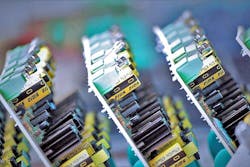U.S. military to put its money where its mouth is in half-billion-dollar anti-tamper program
THE MIL & AERO BLOG – Anti-tamper technology -- or the ability to prevent an adversary from stealing design secrets, reverse-engineer critical components, or dissecting important technologies just to see what makes them tick -- long has been a hot-button issue for the U.S. Department of Defense.
A big emphasis of anti-tamper capabilities has resulted from loss of intelligence data to a thriving black market for counterfeit electronic components, and it seeks to shut-down the kind of technology theft that has been the dark underside of the microelectronics revolution.
The push for anti-tamper technologies to protect critical technologies goes back at least 21 years -- and probably for much longer than that -- to the so-called Hainan Island incident in April 2001 when a U.S. Navy EP-3E ARIES II signals intelligence aircraft was gathering electronic information off the coast of China.
The Chinese People's Liberation Army Navy sent up a J-8II jet fighter to intercept the four-engine Navy turboprop. The jet fighter collided with the Navy reconnaissance aircraft, and forced the EP-3E to make an emergency landing on the Chinese island of Hainan near Vietnam.
Related: Anti-tamper technologies seek to keep critical military systems data in the right hands
Navy personnel aboard the surveillance plane tried to destroy sensitive technology and gathered data, but on landing, the Chinese government impounded the EP-3E, took it apart to learn its secrets, and eventually returned the plane and its on-board systems in various stages of disassembly.
It was this incident that kicked U.S. anti-tamper efforts into high gear, with projects to erase data on hard disks permanently at the push of a button, devices to destroy computers if their covers are removed in an unauthorized way, and advanced encryption to keep software operating systems out of the wrong hands.
With this in mind, the U.S. Air Force is formulating a plan for a 10-year half-billion-dollar initiative called Anti-Tamper Executive Agent Program Office Multiple Award Indefinite Delivery/Indefinite Quantity Contract (MAC ID/IQ) to develop anti-tamper enabling technologies to foil enemy efforts to steal U.S. technology to gain access to its secrets.
The Air Force Life Cycle Management Center at Wright-Patterson Air Force Base, Ohio, has released a draft request for proposal (AT2022DraftRFP) for MAC ID/IQ, which seeks acquisition approval to issue a $499 million 10-year contract solicitation to procure anti-tamper product and technology development of anti-tamper solutions in secure processing; volume protection and sensors; and cryptographic protection.
The objective is to deter, prevent, delay, or respond to reverse-engineering attempts that may compromise critical program information, and prevent adversary countermeasure development, unintended technology transfer, or alteration of a system due to reverse-engineering.
The purpose is to obtain contractor support from large and small businesses in developing unique anti-tamper technologies, integrated anti-tamper technologies.
Secure processing will develop products and technologies to establish and maintain secure processing in single-board computers, custom microelectronics, commercial microelectronics, or modified commercial processing devices, and to extend security from one device to another related to physical hardware, intellectual property (IP), or software that manages security.
Related: Anti-tamper program to protect weapons from theft and reverse engineering
This will involve a secure physical boundary around critical components in products to prevent non-privileged users from gaining access to the critical components or information in line-replaceable units (LRUs) and shop-replaceable units (SRUs).
Cryptographic protection, meanwhile, will protect critical information in products and technology through encrypted algorithms, cryptographic key-generating methods, key storage products, or ways to discourage an adversary from gaining access to key material.
Companies interested were asked to email comments and questions by 9 Sept. 2022 to the Air Force's Sara Smith-Custer at [email protected], and Jonathan Mashburn at [email protected]. More information is online at https://sam.gov/opp/7a7c65049adb4032b991dc6c68dc675c/view.
About the Author
John Keller
Editor-in-Chief
John Keller is the Editor-in-Chief, Military & Aerospace Electronics Magazine--provides extensive coverage and analysis of enabling electronics and optoelectronic technologies in military, space and commercial aviation applications. John has been a member of the Military & Aerospace Electronics staff since 1989 and chief editor since 1995.
